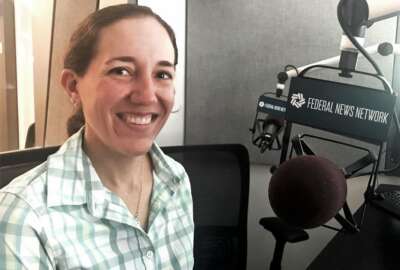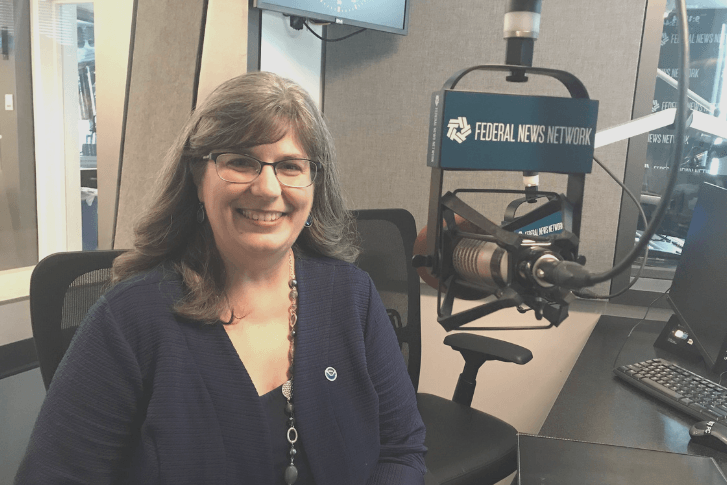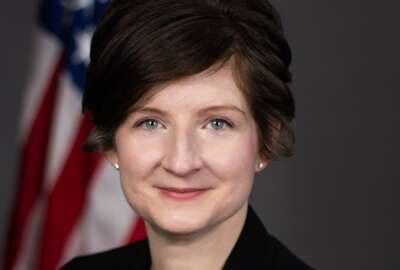

Gigi Schumm welcomes Mary Erickson, deputy director of the National Weather Service, to talk changes in weather forecasting and your career path.
Best listening experience is on Chrome, Firefox or Safari. Subscribe to Women of Washington’s audio interviews on Apple Podcasts or PodcastOne.
Being able to take a step back, reassess and broaden your horizons is an important asset, according to one civil service employee.

On this week’s episode of Women of Washington, Gigi Schumm welcomed Mary Erickson, deputy director of the National Weather Service (NWS). Erickson has held positions across the span of the National Oceanic and Atmospheric Administration for more than 30 years including brief stints with the National Ocean Service and Coast Survey Development Laboratory.
NWS has a mission dedicated to protecting lives and property. How? By providing accurate forecasts to the public on weather, water and climate issues.
One of Erickson’s main responsibilities is to oversee the agency’s change initiatives — including new programs and technology aimed to improve the quality and speed of the forecasts. She said this takes the work of all three components of what is called the “weather enterprise.”
“It’s made of government agencies, academic institutions and I use the term the ‘weather industry,’ [or] folks in the private sector,” she said. “And they’re really along the whole value chain of creating weather forecasts from taking observations, from doing models, having high-performance computing technology [and] all the way through making forecasts and then distributing forecasts.”
The media — one example of a private industry — is a great partner for the NWS in terms of helping to get the word out, Erickson said. It is a vital partnership because whether someone is driving in a car listening to the radio, or at home watching T.V., they can still get the crucial information they need to stay safe.
This includes NOAA Radio, which was created to give even those stakeholders with weak radio signals the ability to stay up to date with weather forecasts. The agency also continues to look into new platforms as technology continues to evolve.
“We’ve recognized, probably just about a decade ago through some devastating tornado outbreak events, that making an excellent, accurate and timely forecast is not enough,” she said. “If you really want to save lives and property, you need to make sure that people hear that message and hear that forecast each morning and understand it.”
Erickson said while meteorology — especially at the national level — is a 24-7-365 type of job, she’s always been interested in the weather, science and math. Originally from upstate New York, she was no stranger to weather changes and had planned to study physics. It was a high school teacher that turned her eyes to her current passion.



“He was an early champion of women in science, so he was mentoring other women in the engineering field and even took me to engineering symposiums and things like that,” she said. “So he always encouraged me to go into science.”
Erickson said women make up about 20% of the NWS workforce. But as they continue to hire new employees, that number continues to grow closer to 30%.
While studying at Penn State University, Erickson was in the Air Force ROTC program. But as her goal to pursue public-sector meteorology became more clear, she dropped out of that program and started an internship program with the National Weather Service.
“I think very early on, I was very drawn to the idea of public service and the nonprofit aspect of applying science to something that mattered to people every day,” she said.
As she moved up the ladder, Erickson said she learned many important lessons on how to be a good leader. She also learned how to build her network and keep ties open between departments.
In any job, there are going to be awkward or unexpected circumstances that arise. Sometimes weather changes, sometimes predictions are wrong and sometimes things happen a little too quickly. One of Erickson’s mentors gave her advice that she said she will always remember: You have to get comfortable with being uncomfortable.
Learning is a continual process. Some of that is taking chances and some of that is getting to know yourself better. Erickson said it’s OK to have weaknesses, but building teams that compensate for those is key.
“I would say that’s the first ingredient: You know what your strengths are. And always try to lead with those strengths. [But] be aware of your shortcomings,” she said. “I think those things help you move forward and take some chances, take some risks. And then every time that you take a risk and succeed, it’s just such a huge energy boost and then you can go on and do more and more things.”
Erickson has also been part of coaching and mentorship programs across NOAA, including one program where younger employees come to the corporate office and shadow more experienced employees, as well as a NWS-specific program aimed at mid-career employees.
Her current position at the NWS is never boring because she’s able to do something different every single day, which helps to feed her curiosity. She said she realized it wasn’t her core expertise to just be interested in one subject.
Erickson’s journey wasn’t necessarily as winding as some, but she said everyone has to find their own way. What worked for her may not work for someone else. There are sacrifices everyone has to make when pursuing their dream career. There is no ultimate solution.
“Don’t try to be finding the ‘perfect’ way. Follow your curiosity, follow what you really enjoy doing and what engages you,” Erickson said. “That’s going to be the best path for you.”
Copyright © 2025 Federal News Network. All rights reserved. This website is not intended for users located within the European Economic Area.
Steff Thomas is a digital editor at Federal News Network.
